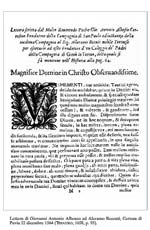Per una storia della Compagnia di San Paolo (1563-1853) – Vol. III
edited by W. Crivellin and B. Signorelli
In the first essay Gli atti ritrovati: fonti per lo studio della Compagnia di San Paolo (1636-1685) Cecilia Laurora and Maria Paola Niccoli present, as a continuation of the study covering the years 1610-1635 published in the first volume of the work, the cataloguing of the deeds drawn up on behalf of the Compagnia and associated institutions, deposited with the Ufficio di Insinuazione. The large quantity of documents found, more than one hundred and fifty deeds in thirty years, testifies to the expansion of the financial and charitable activities.
Indeed there are numerous deeds for setting up and selling back “censi” and the receipts as well as those for setting up dowries in favour of “poor and honourable girls”. Deeds appointing the Compagnia as depository and treasurer and the powers of attorney that allow one to trace the pathways and careers of “sanpaolini”, as members of the brotherhood were known, while transactions regarding real estate and rural property are an invaluable source for the city’s history.
The two essays that follow cover the foundation of the Compagnia and the crisis in the mid-nineteenth century respectively. Eran nel mondo e fuor del mondo … Alle origini della Compagnia di San Paolo is the title of the ample and welldocumented study by Pier Giorgio Longo. The author outlines the religious climate of the period highlighting the plurality of interests and attention given to safeguarding the Catholic faith by various subjects, such as duke Emanuele Filiberto, the city authorities, the Church and the middle and upper classes. From a comparison with the spirituality of other Italian confraternities there emerge a close tie with the Jesuits and the special ability of the brethren of the Compagnia di San Paolo to interpret the needs of society. Several texts dating back to the beginning of the Compagnia are analysed in depth. The long letter written in Latin in 1564 by Giovanni Albosco, one of the seven founders of the Compagnia to the noble decurione Aleramo de’ Beccuti, to convince him to dispose of his property in favour of the Jesuits is “almost a short treatise of spiritual life”, significant testimony to the brethren’s devoutness. The first deeds of establishment of 1563 reveal the “strong sense of distinction in spiritual commitment” on the model of the early Church; the later rewordings of 1591 and 1612, with more attention to the organisational aspects, reflect the development of the institution.
In the third essay L’antica Compagnia di San Paolo nella difficile transizione (1852-1853). Appunti e documenti, Walter E. Crivellin proposes the edition of eleven documents produced by the Compagnia di San Paolo during the two-year crisis, that would conclude with limiting the ancient congregation to the religious sphere and with the setting up of the new publicly appointed body Opere pie di San Paolo. After the unrest of 1848 and later the expulsion of the Jesuits, a parliamentary enquiry was held on the Compagnia, which however acknowledged the honest management of Compagnia’s affairs. However, for the size of its assets and the volume of the business carried out, the State considered it appropriate to flank the confraternity in the administration with a majority of publicly appointed directors. Through the documents collected we can savour the phases of the controversy and the Compagnia’s attitude of total opposition, with a bitter defence of the strictly private nature of the opera pia and sole ownership of the managed assets.
Per una storia della Compagnia di San Paolo (1563-1853),
edited by W. Crivellin and B. Signorelli, vol. III, Torino, 2007




